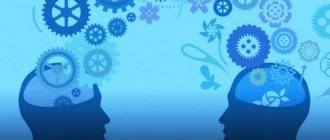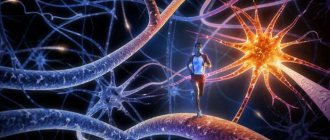It was once thought that the adult brain was not plastic, but it turns out that this is not the case. Individual neurons and entire structures can change connections and form them, adapting to changes. The term “neuroplasticity” was introduced by the Polish neurophysiologist Jerzy Konorski back in the middle of the last century, but neuroplasticity began to be studied relatively recently.
The article was checked by Pavel Sergeevich Dynin, candidate of medical sciences, neurologist at Euromed Clinic.
Synaptic plasticity
A synapse is the gap between two neurons where they exchange information. The active neuron releases neurotransmitters into the synapse, which tell the passive one what to do: activate or remain passive. There are about one hundred billion neurons in our brain, each of which is connected to thousands of others, and the process of “communication” between them takes a fraction of a second. Synaptic neuroplasticity is the “habituation” of neurons to the fact that a particular neuron often excites its “neighbor”. In other words, if neurons communicate frequently, they want to do it more and more often. Just like people.
If this happens to many neurons in one area, entire “teams” of neurons appear—neural networks. This is how memory or new skills are formed. We teach “teams” of neurons to communicate, activating them again and again with our stimulation (we learn to ski, for example), and at some point the connection of the “team” becomes strong and the body easily repeats familiar movements.
On the contrary, if we do not use previously familiar skills for a long time, the paths become overgrown - neurons in this area communicate less frequently, and the connections between them weaken. This is how we forget a foreign language we don’t need, and the patient who finds himself on tube feeding forgets how to swallow. It would seem that there is only harm from this phenomenon, but no: this is how you can, for example, wean yourself from prejudices (by an effort of will, stop thinking badly about people of another nationality) and even ease depression. Cognitive therapists suggest that patients find the usual “paths” along which their depressive thoughts go, and trample others in their place, and leave these ones to “overgrow.” And it works.
Remember everything: general recommendations
If you are faced with a large flow of information at school or at work and you need to constantly keep data in your head, there are ways to add several gigabytes of memory to your brain.
Understand the meanings
According to the “forgetting curve” compiled by the German psychologist Hermann Ebbinghaus, the retention period of new information in the human brain when rote learning and without understanding is not so long. After an hour, you can remember only 60% of what you studied, after 10 hours - 35%, and after a week - no more than 20%.
Meaningful information is loaded into long-term memory and, therefore, is stored much longer, especially if it is periodically repeated correctly.
Repeat correctly
There is a universal algorithm for repeating information, consisting of 3 stages:
- Loading. The goal of the stage is to create the strongest possible neural connection by repeating a small volume: on average, 5 units of information in a row, until the next and previous repetitions are equal in speed.
- Consolidation. The stage consists of regular repetitions of information throughout the week. The goal is to reach maximum speed and maintain it for 7 days, each time increasing the time until the next repetition. You need to repeat it in the same way as at the loading stage.
- Preservation. The main task is to periodically repeat information so that the speed does not decrease.
You will learn a detailed algorithm for correctly repeating information from this video.
Algori
When you repeat information, divide it into 2 types:
- easy to remember;
- not remembered or remembered worse.
This principle makes it convenient to memorize foreign words. If you use cards (the detailed algorithm is described in the article), during the second repetition, divide them into 2 piles: those words that were remembered instantly, and those that were remembered a little more slowly or not remembered at all. You need to work with each group separately, repeating the “difficult” cards more often.
The “Funnel” allows you to repeat easier and more efficiently, so we recommend doing it this way with a large amount of information.
Spaced repetition
With regular spaced repetition, we recall material one time at a time at specific intervals. But these intervals are not suitable for everyone - each person has his own memory characteristics.
Imagine that you need to boil water. It is unlikely that you will turn the gas on and off at certain intervals: after 2 minutes, then after 10, then after 15. It is better to boil the water immediately and maintain the temperature.
The situation is similar with neural connections—intervals only prevent them from becoming established faster. When neural connections are strong, information is forgotten more slowly and recalled more quickly in memory. Why do we remember the famous line “Frost and sun, a wonderful day!”? All this is the work of strong neural connections.
Source: giphy.com
Therefore, you should repeat until the speed of reproduction of the material stops increasing, that is, the pace of the last 4-5 repetitions will be approximately the same. The intervals between the previous and subsequent repetitions should be gradually increased, and the playback speed should always be increased to the maximum. After a while, you will remember what you have learned faster and faster.
Important: with each new repetition cycle, make sure that the playback speed does not drop.
Be positive
Oddly enough, our mood and thoughts directly affect the process. If initially you constantly tell yourself: “I will never be able to learn this” or “I will never cope with this,” then you are unlikely to achieve your goal. Try to use only positive statements to program your brain to work and achieve great results.
Tell yourself: “I will remember everything!”, “I have a good memory, and I can easily retell this difficult paragraph.” Let yourself know that one way or another you will succeed.
Plasticity of entire brain regions
Areas responsible for certain functions can grow and shrink as a result of training. For example, in the cerebral cortex of people who practice piano, the areas responsible for finger movements grow very quickly. Moreover, the areas increased even when study participants only thought about how they would play. It has also been proven that in experienced taxi drivers, the hippocampus, which is also responsible for spatial thinking, becomes larger as their driving experience increases.
This is the basis for the principle of brain rehabilitation after injury or stroke. Let's say the patient's left hand is not working well. He is asked to limit the movements of his healthy arm and try to act with the damaged one. The brain begins to increase the size of the zone responsible for the damaged hand, involving the healthy part of the motor department in the process of controlling the hand, including the corresponding zones in the opposite hemisphere. Thus, the brain reorganizes its activity, adapts, and the hand begins to move better.
Methods associated with biofeedback are based on neuroplasticity. These methods make it possible to better teach the brain to control various functions of the body, for example, vision in some types of vision impairment. The method involves training with devices that provide feedback when performing special exercises. Apparently, three-quarters of our vision is done by the brain. By learning to adapt to those features of vision that cannot be corrected, you can teach the brain to correct an incorrect picture and see more “correctly” with “wrong” eyes. In schools of vision, neuroplasticity is used by performing special tasks: reading inscriptions of different colors and sizes, assessing the distance to an object. The tasks are suggested by a program that evaluates the patient’s progress.
This is interesting. There is a theory that it is our neuroplasticity that is the culprit of phantom pain during limb amputation.
Scientists believe that when the area responsible for sensations coming from an amputated arm or leg is “lost,” neighboring areas rush to take over their function. As a result, the part of the body for which they were originally responsible begins to perceive sensations “for themselves and for that guy” (that is, the amputated limb).
Types of neurons and neural connections
Neurons can be found in various human organs, not exclusively in the brain. A large number of them are located in the receptors (eyes, ears, tongue, fingers - sensory organs). The collection of nerve cells that permeate our body forms the basis of the peripheral nervous system. Let us highlight the main types of neurons.
| Type of neuron cell | What is he responsible for? |
| Affective | They are carriers of information from the sense organs to the brain. This type of neuron has the longest axons. An impulse from the outside enters along axons strictly into a certain part of the brain, sound - into the auditory “compartment”, smell - into the “olfactory” compartment, etc. |
| Intermediate | Intermediate nerve cells process information received from affector neurons and transmit it to peripheral organs and muscles. |
| Effector | At the final stage, efferents come into play and carry the team of interneurons to the muscles and other organs of the body. |
The coordinated work of three types of neurons looks like this: a person “hears” the smell of kebab, the neuron transmits information to the corresponding section of the brain, the brain transmits a signal to the stomach, which secretes gastric juice, the person decides “I want to eat” and runs to buy kebab. This is simply how it works.
The most mysterious are the interneurons. On the one hand, their work determines the presence of a reflex: if you touch electricity, you pull your hand away, dust flies, you close your eyes. However, it is not yet clear how the exchange between fibers gives rise to ideas, images, thoughts?
The only thing that scientists have established is the fact that any type of mental activity (reading books, drawing, solving mathematical problems) is accompanied by a special activity (flare) of nerve cells in a certain area of the brain.
There is a special type of neurons called mirror neurons. Their peculiarity lies in the fact that they not only become excited by external signals, but also begin to “move”, observing the actions of their fellow neurons - other neurons.
What does neuroplasticity depend on?
- From the condition of the blood vessels. The more active the blood supply to the brain, the better the neurons work.
- From age. Still, neuroplasticity is higher in young people than in older people.
- From training. The more often we repeat a certain action, the more intensively and methodically we strive to learn, the higher the likelihood that neurons will cooperate to perform that action.
- From the start of training. After an injury or stroke, it is better to start training as early as possible, since otherwise the brain has time to adapt to what is happening (it stops taking into account the damaged functions), and it becomes more difficult to activate them over time.
- From the variety of practice. The more often we use neuroplasticity, the higher it is. When learning a specific skill, the learning ability of our brain in general increases.
Neuron structure
The figure shows the structure of a neuron. It consists of a main body and a core. Numerous fibers branch off from the cell body, which are called dendrites.
Powerful and long dendrites are called axons, which in reality are much longer than in the picture. Their length varies from a few millimeters to more than a meter.
Axons play a leading role in transmitting information between neurons and ensure the functioning of the entire nervous system.
The junction of a dendrite (axon) with another neuron is called a synapse. Dendrites, in the presence of stimuli, can grow so much that they begin to pick up impulses from other cells, which leads to the formation of new synaptic connections.
Synaptic connections play a significant role in the formation of human personality. Thus, a person with an established positive experience will look at life with love and hope, a person who has neural connections with a negative charge will become a pessimist over time.
Exercises to improve neuroplasticity
All these exercises are related to inviting your brain to do things that are familiar to it in an unusual way and to collect “other teams” of neurons for this. By training the brain to perform unusual actions, we keep it in good shape and improve learning ability.
- Use your non-dominant hand
For starters, you can try brushing your teeth or eating with your other hand. As you get more comfortable with this, switch back to your dominant hand.
- Turn off vision
Try eating, showering, and doing other usual things with your eyes closed (just be careful).
- Change small habits
Find ten new ways to get to work. Have lunch in a different place in your apartment than you usually do.
- See the world upside down
You can do this by looking “under your knees,” as children do, or by turning over familiar objects and looking at them from a different angle.
According to some studies, regular meditation and exercise can also improve neuroplasticity.
era
When the neural network is initialized, this value is set to 0 and has a manually set ceiling. The larger the epoch, the better trained the network and, accordingly, its result. The epoch increases each time we go through the entire set of training sets, in our case, 4 sets or 4 iterations.
It is important
not to confuse iteration with epoch and understand the sequence of their increment. First, the iteration increases n times, and then the epoch, and not vice versa. In other words, you cannot first train a neural network on only one set, then on another, and so on. You need to train each set once per era. This way, you can avoid errors in calculations.
Error
Error is a percentage that reflects the difference between the expected and received responses.
The error is formed every era and must decline. If this doesn't happen, then you are doing something wrong. The error can be calculated in different ways, but we will consider only three main methods: Mean Squared Error (hereinafter MSE), Root MSE and Arctan. There is no restriction on use like there is in the activation function, and you are free to choose any method that will give you the best results. You just have to keep in mind that each method counts errors differently. With Arctan, the error will almost always be larger, since it works on the principle: the greater the difference, the greater the error. The Root MSE will have the smallest error, so it is most common to use an MSE that maintains balance in error calculation. MSE
Root MSE
Arctan
The principle of calculating errors is the same in all cases. For each set, we count the error by subtracting the result from the ideal answer. Next, we either square it or calculate the square tangent from this difference, after which we divide the resulting number by the number of sets.











